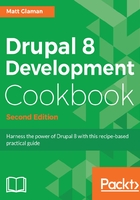
How it works...
The Filter modules provide text formats that control over how rich text fields are presented to the user. Drupal will render rich text saved in a text area based on the defined text format for the field. Text fields with "formatted" in their title will respect text format settings; others will render in plain text.
The Editor module provides a bridge to WYSIWYG editors and text formats. It alters the text format form and rendering to allow the integration of WYSIWYG editor libraries. This allows each text format to have its own configuration for its WYSIWYG editor.
Out of the box, the Editor module alone does not provide an editor. The CKEditor module works with the Editor API to enable the usage of the WYSIWYG editor.
Drupal can support other WYSWIG editors, such as markItUp (http://markitup.jaysalvat.com/home/) or TinyMCE (https://www.tinymce.com/) through contributed modules.